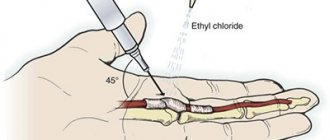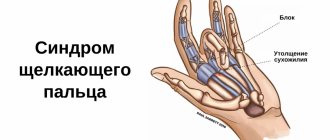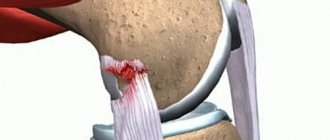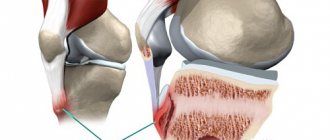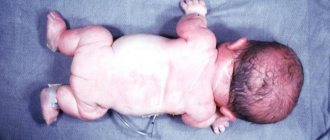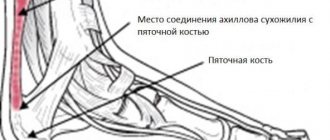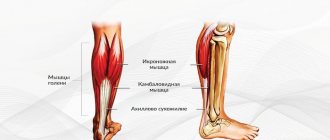Anatomy of the finger tendon
The wrist flexor tendons slide in canals and are covered with a synovial membrane, which produces fluid for the normal gliding of the tendons. The tendons are held in the canal during flexion and extension of the fingers by annular ligaments. All people have anatomical stenosis in the area of the A1 annular ligament (at the junction of the palm and fingers), and therefore are predisposed to the development of this disease.
- Thickening of the tendon sheath
- Annular ligament A1
- Flexor tendon
But when the ligament or synovium thickens due to stress, such as repeated overexertion of the hand at work, then free gliding is impossible.
Causes of trigger finger
More often, trigger finger (stenosing ligamentitis) is observed in women. Especially after menopause. The condition occurs when the tissues surrounding the flexor tendons (synovium) become swollen and make it more difficult for the tendons to slide within the annular ligaments.
Factors contributing to the development of stenosing ligamentitis:
- Heredity is a common factor in stenosing ligamentitis.
- Hormonal changes associated with pregnancy or menopause can cause water retention in the synovial membranes.
- Age - the disease is more common in women after 50-55 years.
- Some systemic diseases can be a cause. Such as diabetes mellitus, rheumatoid arthritis, thyroid dysfunction
Frequent cases of the disease in children. Often trigger finger syndrome is associated with carpal tunnel syndrome.
Treatment with folk remedies. Recipes and dosage regimens
A trigger finger on the hand, which is treated with herbal remedies, cannot always be corrected, and in some cases it may not lead to a positive result. Before starting to use traditional recipes, you should consult your doctor.
Lavender
Lavender oil is often used for sprains and has antiseptic and anti-inflammatory properties. Its components have a sedative effect and can relax certain muscles.
Oil, 1 ml, applied to hands, rubbed into skin for 15 minutes. as part of an aromatherapy massage.
Sagebrush
The herb helps relieve symptoms, a painful condition resulting from inflammation of the joints. It should be noted that the plant itself should never be applied directly to the skin, as its compounds are concentrated and can cause painful burns.
Wormwood infusion:
- Brew ½ tsp. dried or fresh wormwood in 1 cup of boiling water, and leave for 10-15 minutes.
- Do not use more than 1 tsp. herbs and leave for a long time so that you don’t get a strong and bitter drink.
- To remove bitterness, you can add mint or anise to tea instead of sugar.
- Drink several sips 1-2 times a day.
Raw potatoes
Vegetable poultice to relieve inflammation:
- Grate or peel raw potatoes without peeling.
- Place grated potatoes in cheesecloth.
- Place the potato gauze over the affected area of skin and cover with a cloth bandage to secure it in place.
- Leave the poultice on the inflamed skin for 1-2 hours.
Shepherd's Purse
The plant is used for muscle atrophy and joint deformities.
- Grind the plant and put it in a glass bottle. Fill with alcohol (38-40%) and leave for 2 weeks in a bright place. For treatment 1 tsp. tinctures are added to tea. It is best to use the tincture for massage for muscle pain.
- Place fresh shepherd's purse in a metal sieve over a vessel of boiling water and let sit for a while. After steam heating, place the plant on a clean cloth and apply a compress to the affected area. Helps well with muscle atrophy.
Needles
The needles are poured with warm water in a ratio of 1:3, after which they are boiled over low heat for 15-20 minutes. Apply gauze soaked in the solution to the damaged area.
Oats
Oats are one of the richest foods in vitamins and minerals and contain a lot of energy and nutrients.
To prepare a remedy, you need:
- Take 120 g of oatmeal, pour 50 ml of water, add 1 tsp. honey.
- Mix all ingredients in a bowl. The pasta should be warm.
- Apply the composition to the affected area, leave for 20 minutes, and then rinse the skin with cold water. The combination of heat and cold gives a good effect.
Burdock leaves
The plant contains chemicals that fight bacteria and inflammation.
To prepare a remedy, you need:
- Cut the young leaves into small pieces, pack tightly into a glass jar and place in a sunny place. Within a few days, a paste with an unpleasant odor forms in the jar.
- The composition is applied to the sore joint in the form of an application, then wrapping the sore spot with cellophane and a warm cloth. It is better to do the compress at night.
- To consolidate the achieved effect, the plant is applied several times after the pain disappears.
Bird cherry leaves
You can prepare a decoction of the leaves: for this, take 20 g of raw material and boil it in 200 ml of water for no more than 5 minutes. The strained broth is drunk 3-4 times a day, 1/4 cup. Tincture of bird cherry leaves: 50 g of raw material, pour 1 tbsp. vodka and leave to infuse for 2 weeks. The finished infusion is rubbed into sore joints 2 times a day.
Jellied beef bones
It is a natural source of collagen, which helps maintain healthy bones, teeth and joints. Gelatin is responsible for protein absorption.
To prepare a remedy, you need:
- Place meat on the bone (except pork), vegetables (onions, celery, carrots), spices in a saucepan.
- Bring everything to a boil, then reduce heat and simmer for 8 hours.
- Strain the broth twice, add finely chopped meat, garlic and pour into containers. Add a slice of boiled carrots, dill or parsley for decoration.
- Place the aspic in the refrigerator.
Hydrogen peroxide
Hydrogen peroxide relieves pain and significantly improves the condition of the musculoskeletal system.
Compresses are used for treatment: 2 tsp. It is enough to dilute the drug in 50 ml of water. Then soak a cotton cloth in the resulting liquid and apply it to the joint. After about 1 hour, the tissue is removed and the area is lubricated with baby cream.
Eucalyptus decoction
Eucalyptus oil has an analgesic effect and is very useful for sore muscles.
Medicinal properties of eucalyptus
The crushed leaves are poured with boiling water in a ratio of 15:200, boiled for 3-4 minutes, and then the broth is infused for 10-15 minutes. The strained solution is added to water (1 tbsp per 1 glass of water). Rub the mixture in for at least 3-5 minutes. three times a day, the last time preferably at night.
Blue clay
Healing clay is diluted to the consistency of sour cream, 5 tsp is added to it. apple cider vinegar. The mixture is applied to the sore finger, then the joint should be covered with a cloth and kept for about 2 hours, then rinsed with warm water. The hand should not be strained while applying the compress.
Pork fat
Fat restores youth to joints and their natural function, as well as:
- relieves pain and swelling;
- accelerates local blood flow and delivery of beneficial elements to the joint;
- prevents thinning of cartilage and growth of bone spines;
- restores joint mobility.
To treat joints, internal pork fat is rubbed daily for 1 month.
Bear bile
The substance can soothe severe pain, restore impaired motor activity, and remove swelling. Improves blood circulation in the joint area. Larkspur ointment is applied with light rubbing movements 2-3 times a day.
Arnica tincture
Arnica tincture is an external remedy for bruises, sprains, muscle and joint pain. For arnica application, mix 1 tbsp. l. tinctures with 0.5 liters of purified water. Soak a cotton swab or gauze bandage in the mixture, then apply to the joint.
Diagnosis and symptoms of stenosing ligamentitis
A trigger finger is characterized by the inability to straighten the finger independently after flexion. A thickened knot of tendon sheath (one or more fingers) passes the annular ligament with some resistance. Now the finger is “trapped” in a bent position and the patient is often unable to straighten the finger on his own, since the extensor strength is not enough for the tendon to overcome the narrowing of the annular ligament. Over time, flexion and extension begins to be accompanied not only by a click but also by pain. This suggests that the changes are already irreversible and conservative treatment will most likely be unsuccessful. There may be functional limitations in movement, such as loss of full finger flexion. Typically, painful restriction of movement is most noticeable in the morning after a long time without movement.
The diagnosis can be established quite easily during a face-to-face examination of the patient, since the disease causes the finger joint to click.
Is cracking your knuckles harmful?
Cracking your fingers is a very common practice, mainly because people use it to relieve tension. This in itself will not cause arthritis, swelling, or harm the hand. The clicking sound is caused by the bursting of bubbles in the fluid in the joint lining.
Joints are the point of contact where bones meet and are covered with thick synovial fluid. The capsule surrounding the joint stretches and enlarges, while its pressure decreases. When this happens, dissolved gases in the synovial fluid form bubbles. They then “explode”, producing a characteristic clicking sound.
It takes ½ hour for the gas to dissolve in the liquid. This means that the gap between clicks should be at least half an hour. Rapid and repeated stretching and contracting of joint ligaments leads to soft tissue injury and loss of more synovial fluid, a natural lubricant that prevents friction between bones.
If this regular daily habit is repeated over many years, then theoretically the cartilage will be damaged and the joint's ability to grip an object will be reduced over time.
Surgery for stenosing ligamentitis (trigger finger)
The operation is a very effective method of treating trigger finger, as the annular ligament is cut and no longer restricts the movement of the tendons in the canal.
This minor outpatient surgery can be performed under local anesthesia. During the operation, a small incision is made in the skin of the palmar surface of the hand in the projection of the distal palmar fold, and the A1 annular ligament is dissected. To exclude the possibility of relapse, it is better to perform excision of the palmar surface of the ligament. Full range of motion is restored immediately after surgery.
Duration of the operation: on average 30 minutes.
Anesthesia: local or conduction
After the operation, the patient can go home.
